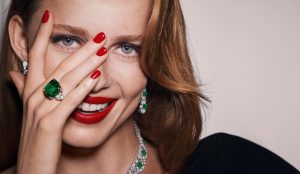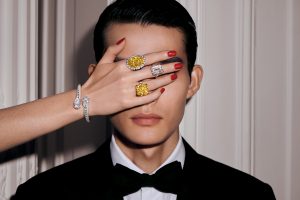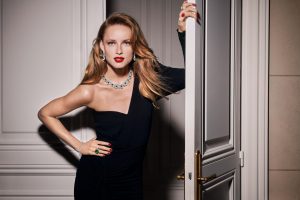
In the realm of high jewellery, Graff is a name synonymous with exceptional craftsmanship and exquisite stones. At the creative heart of this renowned brand is design director Anne-Eva Geffroy, who unveils the delicate dance she and her team have to perform between innovation and simplicity and the increasing role technology has to play in high jewellery design.
How did you become interested in designing jewellery and what inspired you to pursue a career in this field?
I started in luxury, rather than jewellery specifically, designing bags for Louis Vuitton. It was my second master’s degree in luxury design that drove me to jewellery and working at Van Cleef & Arpels was my first step into the sector. I joined them in 2005 to work on their High Jewellery collections and I learned a lot about the beauty of the stone, the beauty of the collection, and the story around its inspiration.
I moved to the UK 14 years ago to work with Graff for the simple reason that it was full of hope, in the sense that the brand has amazing knowledge about the beauty of stones. The creative team was smaller at that time, but they wanted to grow and expand their creations. For me, it was the perfect fit for a person full of creativity and ideas. The freedom Graff gives to the designer is also very unique because you are given a large amount of responsibility and trust with your designs.
Before joining, I knew that the brand was a reflection of the passion of one man, its founder, Laurence Graff, and that he was known for finding exceptional stones. When I joined, I discovered how the Graff family know as much as Laurence Graff about every single facet of the brand. Francois Graff, Laurence’s eldest son is the CEO, with Laurence Graff as Chairman. They have developed a business which uses the very best stones and have always kept that level very high.
You mentioned that you are given a lot of freedom as a designer at Graff. Can you share some insights into that creative process?
We do not follow a specific recipe. The creative process is very natural, like the brand. Because Graff is a family business, we have discussions and contact with the family about the way we want to evolve the designs of the brand. When we come up with an idea, whether it’s around a box of stones or a style that we want to innovate, it is really about sharing ideas together. Often, we brainstorm what we can do and where we would like to go, so it’s a perpetual evolution. The inspiration is always going to be very different. It could be linked to an artist or a specific stone that we want to make the main part of the creation, which means it’s really fresh and different every day. Graff’s reputation is built on its exceptional diamonds and gemstones.
How do you ensure that each piece showcases the unique qualities of these precious stones, and what challenges do you face when working with such valuable materials?
It is full of challenges because we only work with precious stones: rubies, sapphires, diamonds and emeralds. When you only focus on these types of stones, it is tricky to find a design that is both very simple and reflects the beauty of the stone. You don’t want the design and the stone to have to fight one another. We have to keep that simplicity in mind with every technical request in creating a necklace or bracelet. Playing and designing with stone, always requires you to be very vigilant so that the jewellery is wearable, flexible and light while showing off all that is magical about the stone.
Can you give some examples of a precious stone that has stood out for you?
In a recent High Jewellery collection, we had a big sapphire. It was very important that the design for the stone fitted with the theme, but was very light at the same time, so you could see the beauty of the cut, in levitation, in the design. Sometimes when you have a stone that is so exceptional, you really want to integrate it into a special design, so you have to look at how the light reflects off it and create something very simple and elegant around it.
A stone can dictate how you’re going to approach the design. It often works this way instead of the other way around, where you design the jewellery and find a stone after. It’s much easier to create something beautiful when the stone is in front of you. It is like designing shoes for the princess that only fit her feet. The jewellery you create will only fit this stone. You would not be able to replace the stone for another one. It really is sur mesure, the French term for “bespoke”.
Is the integration of technology such as 3D printing and computer-aided design becoming more important to your field of work?
Absolutely. You can’t avoid it, because if you do, it would be such a mistake. You learn so much with new technology because it gives you the opportunity to produce a lot of prototypes. We sometimes print our ideas to see the angle, to see if the design is nice or light or heavy. Also, all this technology really plays with the limits of feasibility and gives you a three-dimensional view of some elements straightaway, and then afterwards you can translate it in the workshop and build it in real life.
The computer, for us, is really a tool and a helpful element to mix with human knowledge — you can’t draw or build without a human being involved. High jewellery, to be absolutely perfect needs soul and emotion. When you draw something in the studio, you always start with your own idea, with your hand going everywhere on the page. The technical approach gives you a guide for improving your design by hand. Technology is never going to be something that takes over drawing or thought, but we will use the tools to see if we want to go in a certain direction or not. I’m always afraid when I see a 3D printed design because it’s so flat and there’s no soul, so it’s very important to involve your own emotions. You can use every tool you have in your hands but it will always be translated in the end with your own thoughts. A computer is like mixing some calculations to arrive at a point — and fine, it did its job — but it’s missing these little accidents that make everything different. Sometimes you think you will take a right but actually, if you take the left, you will see a lovely little pond with flowers that you will miss if you go in the opposite direction.
Butterflies, birds, and botany are recurring motifs in Graff’s designs. Could you elaborate on how natural elements inspire your creations and how they are incorporated into the jewellery? Was that something that inspired your designs at Van Cleef & Arpels as well?
Van Cleef & Arpels has a very different story so you can’t really compare the two brands. Each jeweller brings its own distinctive touch to flowers, birds and butterflies. For Graff, I will say that it is always organic, in that we try to translate a moment or emotion each time. It is like when you try to photograph a butterfly landing on a flower, which you know is only going to stay for two seconds. We try to capture this kind of fleeting moment.
It is the same for birds or any kind of natural element. We don’t want the flowers in our jewellery to feel like they are generated by a computer, we want it to feel like you picked up the flower in the morning and you still have it in your hands. It’s an approach I think our customers appreciate because it’s not repetitive. You can also find this organic approach in our other shapes like the bow — everything should feel like you are wearing a little part of nature.
Could you share some examples of pieces you’ve designed that hold a special narrative or emotion for you?
I approach every single design with emotion because we speak, in this company, with so much passion all the time. When you have an idea, and it is burning, you have to share it. Some of the pieces that I really like are the result of having designed ten different versions, with one being fantastic. You share your design with the family and they also favour the same one. We all care so much from the very beginning when we receive the stone and it has been cut and polished perfectly. We really want to show it in the best way, so it is an amazing feeling when you find the right design. Then when the client agrees, and they are buying the jewellery, I think, “Wow, well done”. We really appreciate and respect the stone, so it’s important to always pay attention to the jewellery we are going to create for it.
What are the future trends and directions for this field of design that Graffis looking at?
Because we are very close to our customers and the trends and fashion, we are always switching between different kinds of moods. We are also extending our everyday jewellery. This is something that I think we will focus more on in the future with the same savoir faire and care we put into our High Jewellery pieces. High Jewellery is our core identity and will always be there, but we will extend the type of jewellery that clients see when they push open the door of a boutique, and wear every day. Gifting jewellery has become a prominent tradition during the festive season. As a designer, do you actively consider seasonality when curating specific collections? I think that every festive moment is one to also show incredible pieces. We are going to select pieces from our High Jewellery collections but also shine a light on jewellery from our diamond collections, so we are offering something for everyone.
What have been the most valuable lessons you have learned during your career as a luxury designer?
First of all, listen — a lot — because you can be too closed in your artistic feeling and, actually, it’s very important to feel the mood of the moment. It’s very important to be international, to feel what’s going on, and to also look at other disciplines like fashion and architecture. I think you always have to embrace everything. That is one thing that is so important: not to close yourself off and never think you are at your best. You always have more to learn. Another lesson is to trust yourself and trust your team.
Giving freedom to someone will always make them grow. When someone grows, you grow with them. It is great to bring in talent and share it. That is something precious to keep. I think the exercise at Graff is always to keep it simple but beautiful. Simplicity is very hard, honestly, because you have to have new ideas, and it is easy to be suddenly overwhelmed and keep adding but actually, you have to find something simple and beautiful. It is great because with the family we can always propose a different theme, and because Graff is still a young brand, you can go in a very different direction. You are not dragged down by tradition. You are writing the next chapter all the time and you are already part of the future and the present. You are writing the future for the next generation that will take over. We might look at what we did in the past, and we’ll probably consider that as the archive, but we are the generator of ideas of the moment.
What advice would you offer aspiring luxury designers?
Sometimes, I receive requests for my advice about getting into the sector. I will always respond that they have to be a chameleon, because it’s very important to be able to create for everyone. When you are a chameleon, you can capture the DNA of a brand better and be able to propose something with your style. It is very important to keep your own ideas and feelings but you have to mix them with the brand you’re going to work with. The computer is not your friend, it is your tool, and I would really like the new generation to understand that ideas come from your head. Ideas are generated from your emotions, and this is something you can capture. You have to really nurture and build that within yourself; as a sensation, as ideas, as shapes. You have to be a chameleon and be able to capture something — you have to be the camera. You have to also be the film inside the camera after you develop it. If you have plenty of other ideas, you can mix them to create great things, but all from your own mind. When you have a portfolio that shows universal creativity — and that does not have to be specifically in jewellery — you know this person is able to do amazing things because you learn the technique afterwards. Learning how to create the idea has to come from you.
Images from Graff’s ‘I Wish’ Festive Campaign.
graff.com



